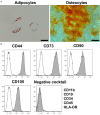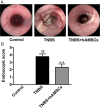Therapeutic effects of human amnion-derived mesenchymal stem cell transplantation and conditioned medium enema in rats with trinitrobenzene sulfonic acid-induced colitis
- PMID: 28386323
- PMCID: PMC5375988
Therapeutic effects of human amnion-derived mesenchymal stem cell transplantation and conditioned medium enema in rats with trinitrobenzene sulfonic acid-induced colitis
Abstract
Cell therapy with mesenchymal stem cells (MSCs) is expected to provide a new strategy for the treatment of inflammatory bowel disease (IBD). Large amounts of MSCs can be obtained from human amnion. Therefore, we investigated the effect of transplantation of human amnion-derived MSCs (hAMSCs) or enema of conditioned medium (CM) from hAMSCs into rats with 2,4,6-trinitrobenzene sulfonic acid (TNBS)-induced colitis. In the first experiment, 10-week-old male Sprague-Dawley rats were intravenously injected with hAMSCs (1 × 106 cells) 3 h after rectal administration of TNBS (45 mg/kg). In the second experiment, rats with TNBS-induced colitis received CM by enema into the colon for 3 days. Colitis was investigated by endoscopy, histology, immunohistochemistry, and by measuring mRNA expression of inflammatory mediators. Administration of hAMSCs or CM enema significantly improved the endoscopic score. In addition, these two interventions resulted in significantly decreased infiltration of neutrophils and monocytes/macrophages and decreased expression levels of TNF-α, CXCL1, and CCL2. In conclusion, transplantation of hAMSCs and CM enema provided significant improvement in rats with TNBS-induced colitis. CM from hAMSCs and hAMSCs may be new strategies for the treatment of IBD.
Keywords: Mesenchymal stem cells; amnion; colitis; conditioned medium; trinitrobenzene sulfonic acid.
Figures








Similar articles
-
Effects of human amnion-derived mesenchymal stem cells and conditioned medium in rats with sclerosing cholangitis.Am J Transl Res. 2018 Jul 15;10(7):2102-2114. eCollection 2018. Am J Transl Res. 2018. PMID: 30093947 Free PMC article.
-
Human Amnion-Derived Mesenchymal Stem Cell Transplantation Ameliorates Dextran Sulfate Sodium-Induced Severe Colitis in Rats.Cell Transplant. 2015;24(12):2601-14. doi: 10.3727/096368915X687570. Epub 2015 Mar 25. Cell Transplant. 2015. PMID: 25812083
-
Mesenchymal stem cells and conditioned medium avert enteric neuropathy and colon dysfunction in guinea pig TNBS-induced colitis.Am J Physiol Gastrointest Liver Physiol. 2014 Dec 1;307(11):G1115-29. doi: 10.1152/ajpgi.00174.2014. Epub 2014 Oct 9. Am J Physiol Gastrointest Liver Physiol. 2014. PMID: 25301186
-
Allogeneic guinea pig mesenchymal stem cells ameliorate neurological changes in experimental colitis.Stem Cell Res Ther. 2015 Dec 30;6:263. doi: 10.1186/s13287-015-0254-3. Stem Cell Res Ther. 2015. PMID: 26718461 Free PMC article.
-
Human Amnion Membrane-Derived Mesenchymal Stem Cells and Conditioned Medium Can Ameliorate X-Irradiation-Induced Testicular Injury by Reducing Endoplasmic Reticulum Stress and Apoptosis.Reprod Sci. 2022 Mar;29(3):944-954. doi: 10.1007/s43032-021-00753-6. Epub 2021 Oct 12. Reprod Sci. 2022. PMID: 34642916
Cited by
-
Early-phase administration of human amnion-derived stem cells ameliorates neurobehavioral deficits of intracerebral hemorrhage by suppressing local inflammation and apoptosis.J Neuroinflammation. 2022 Feb 12;19(1):48. doi: 10.1186/s12974-022-02411-3. J Neuroinflammation. 2022. PMID: 35151317 Free PMC article.
-
Therapeutic Effect of Mesenchymal Stem Cells in Ulcerative Colitis: A Review on Achievements and Challenges.J Clin Med. 2020 Dec 3;9(12):3922. doi: 10.3390/jcm9123922. J Clin Med. 2020. PMID: 33287220 Free PMC article. Review.
-
Stem cell therapy for Crohn's disease: systematic review and meta-analysis of preclinical and clinical studies.Stem Cell Res Ther. 2021 Aug 18;12(1):463. doi: 10.1186/s13287-021-02533-0. Stem Cell Res Ther. 2021. PMID: 34407875 Free PMC article.
-
Effects of human amnion-derived mesenchymal stem cells and conditioned medium in rats with sclerosing cholangitis.Am J Transl Res. 2018 Jul 15;10(7):2102-2114. eCollection 2018. Am J Transl Res. 2018. PMID: 30093947 Free PMC article.
-
The Achievements and Challenges of Mesenchymal Stem Cell-Based Therapy in Inflammatory Bowel Disease and Its Associated Colorectal Cancer.Stem Cells Int. 2020 Mar 18;2020:7819824. doi: 10.1155/2020/7819824. eCollection 2020. Stem Cells Int. 2020. PMID: 32256612 Free PMC article. Review.
References
-
- Feagan BG, Vreeland MG, Larson LR, Bala MV. Annual cost of care for Crohn’s disease: a payor perspective. Am J Gastroenterol. 2000;95:1955–1960. - PubMed
-
- Baumgart DC, Carding SR. Inflammatory bowel disease: cause and immunobiology. Lancet. 2007;369:1627–1640. - PubMed
-
- Kaplan GG. The global burden of IBD: from 2015 to 2025. Nat Rev Gastroenterol Hepatol. 2015;12:720–727. - PubMed
-
- Mowat C, Cole A, Windsor A, Ahmad T, Arnott I, Driscoll R, Mitton S, Orchard T, Rutter M, Younge L, Lees C, Ho GT, Satsangi J, Bloom S IBD Section of the British Society of Gastroenterology. Guidelines for the management of inflammatory bowel disease in adults. Gut. 2011;60:571–607. - PubMed
-
- Sands BE, Anderson FH, Bernstein CN, Chey WY, Feagan BG, Fedorak RN, Kamm MA, Korzenik JR, Lashner BA, Onken JE, Rachmilewitz D, Rutgeerts P, Wild G, Wolf DC, Marsters PA, Travers SB, Blank MA, van Deventer SJ. Infliximab maintenance therapy for fistulizing Crohn’s disease. N Engl J Med. 2004;350:876–885. - PubMed
LinkOut - more resources
Full Text Sources
Other Literature Sources
